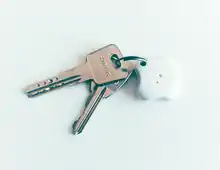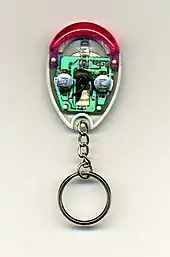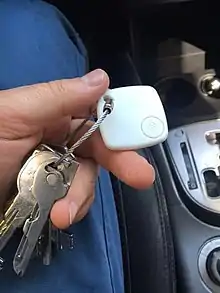Key finder
Key finders, also known as keyfinders, key locators, or electronic finders, are small electronic devices used to locate misplaced or stolen objects, such as keys, luggage, pets, or tools, and to transmit alerts, e.g., that one's restaurant table is ready or a nurse is needed. Some key finders beep or flash lights on demand.

Types
Sound-based

Early models of key finder were sound-based, and listened for a clap or whistle (or a sequence of same), then beeped for the user to find them. Determining what was a clap or a whistle proved difficult, resulting in poor performance and false alarms. Because of this low quality and unreliability, these early key finders were soon discarded and were unpopular for serious needs.
Radio
As electronics became smaller and cheaper, and battery life improved, radio became viable to locate the keys, which were fitted with a small receiver. A separate transmitter is used to activate one or more receivers. All wireless key finders have to "listen" for a searching transmission, resulting in battery replacement at intervals ranging from 3 months to a year. Using a radio signal removes the risk of false alarms.
Some distributors include a cost-effective key-return service that assists in returning the keys should they be lost in a taxi, bus or other public place, provided the customer registered their devices and contact information. The transmitter can also contain information to help return it to its rightful owner.
Peer-to-peer
Peer-to-peer key finders no longer require a separate "base"; they are all functionally identical and based on a communication system wherein each device can find all the others individually. The user can, for example, use a digital wallet to find misplaced keys and vice versa, or a mobile phone to find a lost TV remote control or eyeglasses. In addition, since the keyfinders have their own transmitters, they can reply to each other by radio as well as by beeping and flashing a light to attract attention. The seeking unit can then follow this beacon to find even a buried set of keys. Having a transmitter in each unit also means that, unlike second generation units, losing a single transmitter does not result in total loss of the ability to find other items it tracks.
Bluetooth low energy beacon
Modern key finders use a Bluetooth low energy beacon to broadcast a uniqueID that is picked up by nearby phones running the appropriate software, that is then reported to the manufacturer's website along with the location where they picked up the signal. Even though different manufacturers use the same underlying technology and standards, their apps do not share information with each other, so each manufacturer requires a different app for its devices.
Example of trackers that work this way are Chipolo, ON!Track (by Hilti), Tick (by Milwaukee Electric Tool Corporation), Tile, TrackTag (by Bosch), TrackR[1] and PROTAG.
Uses
Typical user experience
A typical usage is to attach a key finder device to a set of keys, and if these keys are lost or misplaced, to perform an action to initiate the search functionality (such as clapping or pressing a button on the locator device). Modern key finder devices are able to: 1) generate a distinct sound, such as a beep or tone; 2) flash a light, and/or; 3) somehow guide a user toward the lost item.

Key finders have also been found to be useful for the visually challenged, as well as those with memory problems associated with Alzheimer's disease or problems paying attention typical of attention deficit hyperactivity disorder (ADHD). Additionally, military combat veterans suffering from post-traumatic stress disorder (PTSD) are finding key finders useful in combating the memory effects of the disease.
Modern life requires most urban dwellings, cars, and offices to be accessed via a key, and the stress, cost, and inconvenience of losing one's key to access those environments are high. Key finders are a practical way to alleviate these effects.
Novel uses
- Animals – Key finders can be placed on the collar of a house pet (or on a turtle's shell[2]) to keep track of them.
- Hospitals – Key finders can be utilized to summon people in a ward, to whom key finder is attached, such as a nurse.
- Museums – "Museums make use of beacons strategically placed indoors to communicate with their guide app about which room the user is currently in, and therefore display information about the current exhibits."[3]
- Restaurants – Patrons given key finders can be alerted when their meals or seats are ready.
- Tools - Tools can be tagged to monitor their location as a deterrent against misplacement and theft.[4]
- Travel – Key finders can be placed in luggage or attached to personal items (e.g., camera kits, laptop computers, medication, mobile devices, or passports) to ensure they are not left behind, misplaced, nor stolen while traveling.
- Treasure hunts for the blind – Key finders can be placed in strategic locations to assist the blind with improving their auditory location ability.
See also
References
- "Bosch TrackTag, a Bluetooth Tracking Device You Attach to Your Tools". ToolGuyd. 2015-09-08. Retrieved 2019-10-08.
- "smart-home-reviews/tile-sticker-slim-mate-pro-hands". DigitalTrends. October 2019.
- Bruce, James (November 9, 2015). "With Find My Stuff, Nothing Will Ever Go Missing Again". makeuseof.
- "The Milwaukee Tick, a One-Key Tool Tracker". ToolGuyd. 2017-01-06. Retrieved 2019-10-08.
Bibliography
- http://www.uspto.gov Patent# 6,774,787 Electronic locator system and method
